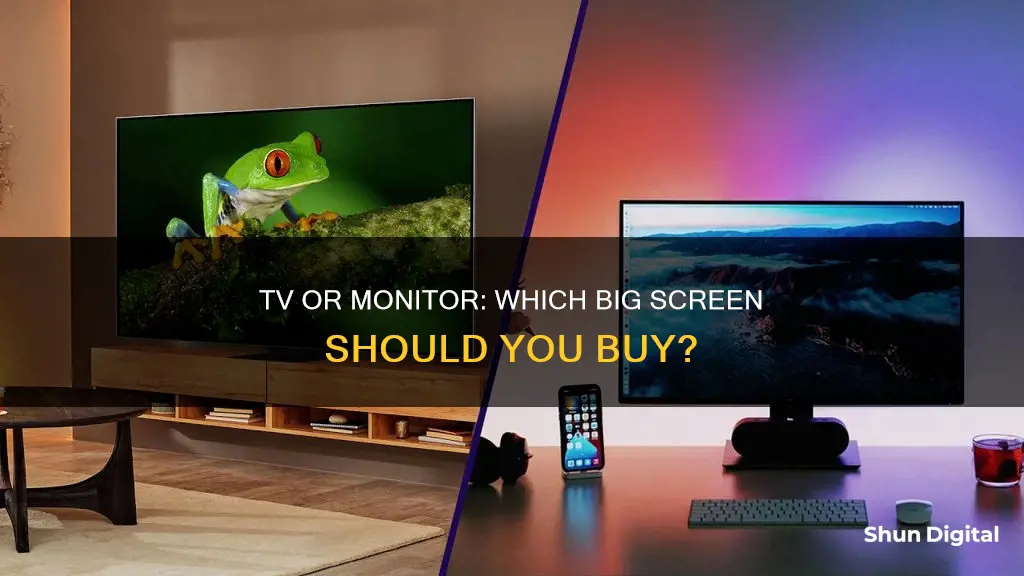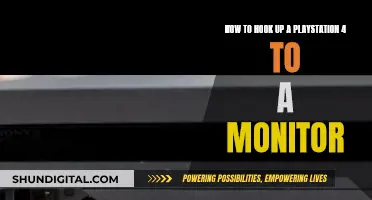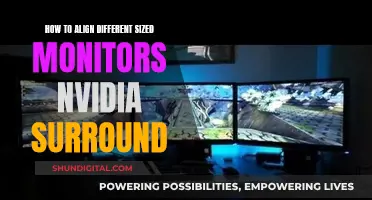
Choosing between a TV and a monitor can be a difficult decision, especially if you're a gamer. While TVs and monitors have a lot in common, they also have distinct purposes and key differences. If you're looking for a display for gaming, there are several factors to consider, including input lag, refresh rate, response time, and display size.
| Characteristics | Values |
|---|---|
| Purpose | Monitors are designed for close-up use and have sharper, more detailed displays. TVs are designed for viewing from a distance and have a poorer picture quality up close. |
| Size | TVs are available in sizes ranging from 19 to 85 inches or larger. Monitors range from 15 to 50 inches. |
| Aspect Ratio | Monitors offer more variety in aspect ratios, while TVs typically have a standard 16:9 widescreen ratio. |
| Ports | TVs have more ports, including HDMI, VGA, USB, DVI, and coaxial. Monitors have fewer ports but can be expanded using adaptors and bridges. |
| Price | TVs can be more expensive, ranging from $100 to $50,000. Monitors range from a couple of hundred to a few thousand dollars. |
| Screen Resolution | Both TVs and monitors have resolutions up to 8K. Monitors have resolutions of 1366x768 or 1920x1080 pixels, while TVs have Full HD or 4K UHD resolutions. |
| Screen Type | TVs are available in LCD, LED, OLED, and QLED. Monitors have LCD, LED, and IPS screens. |
| Input Lag | Monitors have lower input lag, making them better for gaming. |
| Refresh Rate | Monitors have higher refresh rates, reaching up to 240Hz, while TVs are typically limited to 60-120Hz. |
| Response Time | Monitors have faster response times, reducing the "ghosting" effect. |
| Features | TVs often include built-in speakers and DVD players, while monitors offer additional USB ports for faster data transfer. |
What You'll Learn

Monitors are better for close-up use
Televisions, on the other hand, are designed for viewing from across the room, so they don't need to produce such close-up detail. A 27" monitor will always be able to produce a sharper image than a 50" TV with the same resolution. As the screen gets bigger, the pixels become more spaced out, so text and fine detail become blurry and hard to read.
Monitors are also better for close-up use because they have a faster response time than TVs. This is the duration it takes for a screen's pixels to switch colours between scenes. TVs tend to prioritise richer colours, higher contrast, and wider viewing angles, which results in a longer response time. This can cause "ghosting" in fast-paced video and gaming sequences.
Monitors are also better for close-up use because they have a lower input lag. Input lag is the delay between a movement on your input device (e.g. a mouse or keyboard) and the display on the screen. While most monitors prioritise minimal lag times, TVs generally do not, instead prioritising video processing. These extra milliseconds can make a massive difference if you're doing something like competitive online gaming.
In summary, monitors are better for close-up use because they have more pixels per inch, a faster response time, and a lower input lag.
Ultimate Monitor Size for the Nintendo Unisystem Arcade
You may want to see also

TVs are better for media centres
If you are looking for a media centre to replace your old TV, a big-screen TV is a better option. TVs are larger and more affordable, so they are perfect for watching movies and TV shows. They are also great for console gaming.
TVs usually have more HDMI, VGA, USB, DVI, and coaxial ports. They also have a coaxial cable and a port for an antenna, which computer monitors do not have.
While TVs are only available in Full HD and 4K UHD resolutions, monitors have an in-between option called QHD with 2560×1440 pixels. Moreover, there are ultra-wide monitors with 21:9 and 32:9 aspect ratios for a more immersive viewing experience.
For a media centre, you will want to have a variety of devices connected to your screen. With more ports, TVs are more suitable for this purpose.
If you are looking for something for the whole family to use for film nights, a big-screen TV is a better option than a monitor.
Disabling Aim Mode on ASUS Monitors: A Step-by-Step Guide
You may want to see also

Monitors have better input lag
If you are looking for a screen for gaming, a monitor is a better choice than a TV due to its lower input lag, higher refresh rates, and faster response times.
Input lag is the amount of time it takes for your monitor to display an image or input on the screen from when it receives it. For gaming, low latency is crucial for a smooth and responsive experience. Monitors have lower input lag than TVs, making them a better choice for gaming.
While TVs are larger and more affordable, making them fantastic for watching movies and TV shows, monitors are a better choice for gaming due to their lower input lag. Monitors also have higher refresh rates and faster response times than TVs.
The input lag of a display depends on its resolution and refresh rate. Monitors typically have lower input lag than TVs at the same resolution and refresh rate. Additionally, monitors with higher refresh rates tend to have lower input lag.
When choosing between a TV and a monitor, it is important to consider your intended use. If you are looking for a general display for your home office or bedroom, a monitor is a good choice. However, if you are looking for a media center to replace your old TV, a big-screen TV may be a better option.
Breaking an LCD Monitor: Step-by-Step Guide
You may want to see also

TVs are more affordable
When it comes to affordability, TVs are generally the more cost-effective option. While there are exceptions, with some high-end TVs carrying a hefty price tag, on the whole, TVs are more affordable than monitors. This is especially true when you consider the size of the display you are getting.
For example, a TV can be purchased for as little as $100, and even high-end models with all the latest features can be found for a few thousand dollars. In contrast, a monitor will typically cost a few hundred to a few thousand dollars, with prices increasing significantly for larger sizes. So, if you are looking for a big screen, a TV will usually be the more budget-friendly option.
Additionally, TVs often offer more features for the price. For instance, TVs usually have more HDMI, VGA, USB, DVI, and coaxial ports than monitors, and some models even include built-in DVD players or other features. Monitors, on the other hand, tend to be more expensive for equivalent resolutions and may not include as many additional features.
It is worth noting that, while TVs are generally more affordable, there are times when a monitor may be a more cost-effective choice. For example, if you are looking for a smaller display (under 27 inches) to use up close, a monitor will often be cheaper than a TV of the same size and resolution.
In summary, while there are exceptions, TVs are typically more affordable than monitors, especially when considering the size of the display and the number of features included. However, for smaller displays intended for close-up use, a monitor may be the more budget-friendly option.
Shroud's Monitor: Size and Setup Secrets
You may want to see also

Monitors have better picture quality
When it comes to picture quality, monitors generally have the upper hand over TVs. This is mainly due to their higher resolution, which can make a significant difference when viewed up close. For example, a 24" monitor will typically have a higher resolution than a 60" TV, resulting in a clearer and less blurry image. This is especially noticeable when displaying smaller fonts or detailed graphics.
Additionally, monitors often have faster response times, resulting in less ghosting and trailing behind fast-moving objects. The average IPS panel monitor has a response time of around 5ms, while an IPS panel TV usually has a response time of around 15ms. This can be an important factor for those seeking a smooth and responsive viewing experience, particularly for gaming or fast-paced media.
Another factor to consider is input lag, which is the time it takes for the screen to update after a change is made. Monitors generally have lower input lag, making them more responsive and reducing potential choppiness. This is especially important for gaming, where smooth and responsive gameplay is crucial.
While TVs may offer larger screen sizes, monitors provide superior picture quality due to their higher resolution, faster response times, and lower input lag. These factors make monitors ideal for tasks requiring detailed visuals, such as gaming, graphic design, or video editing.
It is worth noting that some high-end TVs, particularly OLED and QLED models, can offer exceptional picture quality that rivals or even surpasses that of monitors. However, these TVs tend to be more expensive and may not be as readily available as their monitor counterparts. Ultimately, the decision between a TV and a monitor depends on your specific needs and preferences.
Unlocking 144Hz: Maximizing Your ASUS FHD Monitor
You may want to see also
Frequently asked questions
TVs are generally larger than monitors, with sizes ranging from 19 to 85 inches or more. They are also typically more affordable than monitors.
TVs are designed for viewing from a distance, so they don't need to produce very close-up detail. This means that the pixels become more spaced out the bigger the screen becomes, and text and fine details become blurry and hard to read.
Monitors have more pixels per inch than TVs, meaning they can display very fine detail. They also have lower input lag, higher refresh rates and faster response times than TVs, making them a better choice for gaming.







